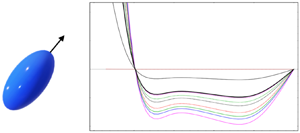Published online by Cambridge University Press: 03 November 2023

We study the cross-stream inertial migration of a torque-free neutrally buoyant spheroid, of an arbitrary aspect ratio  $\kappa$, in wall-bounded plane Poiseuille flow for small particle Reynolds numbers (
$\kappa$, in wall-bounded plane Poiseuille flow for small particle Reynolds numbers ( $Re_p\ll 1$) and confinement ratios (
$Re_p\ll 1$) and confinement ratios ( $\lambda \ll 1$), with the channel Reynolds number,
$\lambda \ll 1$), with the channel Reynolds number,  $Re_c = Re_p/\lambda ^2$, assumed to be arbitrary; here
$Re_c = Re_p/\lambda ^2$, assumed to be arbitrary; here  $\lambda =L/H$, where
$\lambda =L/H$, where  $L$ is the semi-major axis of the spheroid and
$L$ is the semi-major axis of the spheroid and  $H$ denotes the separation between the channel walls. In the Stokes limit (
$H$ denotes the separation between the channel walls. In the Stokes limit ( $Re_p =0)$, and for
$Re_p =0)$, and for  $\lambda \ll 1$, a spheroid rotates along any of an infinite number of Jeffery orbits parameterized by an orbit constant
$\lambda \ll 1$, a spheroid rotates along any of an infinite number of Jeffery orbits parameterized by an orbit constant  $C$, while translating with a time-dependent speed along a given ambient streamline. Weak inertial effects stabilize either the spinning (
$C$, while translating with a time-dependent speed along a given ambient streamline. Weak inertial effects stabilize either the spinning ( $C=0$) or tumbling orbit (
$C=0$) or tumbling orbit ( $C=\infty$), or both, depending on
$C=\infty$), or both, depending on  $\kappa$. The asymptotic separation of the Jeffery rotation and orbital drift time scales, from that associated with cross-stream migration, implies that migration occurs due to a Jeffery-averaged lift velocity. Although the magnitude of this averaged lift velocity depends on
$\kappa$. The asymptotic separation of the Jeffery rotation and orbital drift time scales, from that associated with cross-stream migration, implies that migration occurs due to a Jeffery-averaged lift velocity. Although the magnitude of this averaged lift velocity depends on  $\kappa$ and
$\kappa$ and  $C$, the shape of the lift profiles are identical to those for a sphere, regardless of
$C$, the shape of the lift profiles are identical to those for a sphere, regardless of  $Re_c$. In particular, the equilibrium positions for a spheroid remain identical to the classical Segre–Silberberg ones for a sphere, starting off at a distance of about
$Re_c$. In particular, the equilibrium positions for a spheroid remain identical to the classical Segre–Silberberg ones for a sphere, starting off at a distance of about  $0.6(H/2)$ from the channel centreline for small
$0.6(H/2)$ from the channel centreline for small  $Re_c$, and migrating wallward with increasing
$Re_c$, and migrating wallward with increasing  $Re_c$. For spheroids with
$Re_c$. For spheroids with  $\kappa \sim O(1)$, the Jeffery-averaged analysis is valid for
$\kappa \sim O(1)$, the Jeffery-averaged analysis is valid for  $Re_p\ll 1$; for extreme aspect ratio spheroids, the regime of validity becomes more restrictive being given by
$Re_p\ll 1$; for extreme aspect ratio spheroids, the regime of validity becomes more restrictive being given by  $Re_p \kappa /\ln \kappa \ll 1$ and
$Re_p \kappa /\ln \kappa \ll 1$ and  $Re_p/\kappa \ll 1$ for
$Re_p/\kappa \ll 1$ for  $\kappa \rightarrow \infty$ (slender fibres) and
$\kappa \rightarrow \infty$ (slender fibres) and  $\kappa \rightarrow 0$ (flat disks), respectively.
$\kappa \rightarrow 0$ (flat disks), respectively.